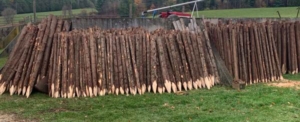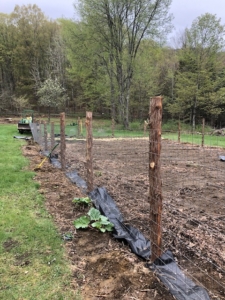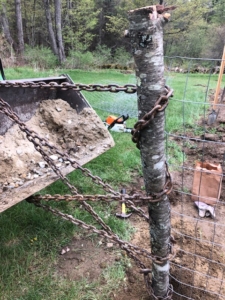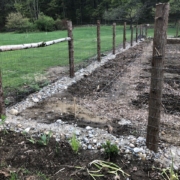Turning a Patch of Lawn into a Vegetable Garden, Part 3
It’s time to figure out a fence for the garden, and the options seem endless and imperfect. I’m going to want to keep cottontails, woodchucks, deer, and birds out, and so the logical solution is a 2,000-foot cage. Of course I also want an aesthetically pleasing place to be, so right away the practically-perfect is the enemy of the good.
In past gardens I’ve used single-strand electric fence, three courses high. And it worked well for deer. I’d smear peanut butter on the wire to train them. Each fall the fence came down, and each spring a tractor could till, unimpeded. The downside was that it wasn’t effective for cottontails or woodchucks, who could go right under. And it was a pain to weed-whack, which is important because the grass growing up into it shorts the electricity. And I want to try to not use a tractor anymore, so the fact that I can remove it easily is no longer as big a plus as it was.
So I decided to go the classic welded 2 x 4 wire route. The pros are that this fence thwarts woodchucks and bunnies. The structure can also be nice, either as a means of growing vertically or as a way to help suspend bird netting over vulnerable crops. The downside, besides the fact that it’s labor intensive to build and maintain, is that it still leaves you with a deer problem. They can jump 8 feet, and so to really keep them out you’d have to run two courses of 4 foot wire and turn the whole plot into a prison cell.
I’m hoping to get around this by running one 4-foot course of wire, then messing with the deers’ depth perception, an idea codified by UVM’s Leonard Perry in this online article. If I put 45 degree kickers on the corners which will go out and up, away from the fence, I’m hoping that maybe a single strand of wire will leave them hesitant to jump.
Once the decision on fence style was made, it was time to source posts. Cedar makes good posts. Locust makes good posts. Unfortunately, I have neither of these species growing on the back 40. So I went online and found Ed Fox, a farmer in Pittsford, who was selling freshly cut white cedar posts for $5.50 each. This seemed like a good deal to me. Plus I got to use Vermont wood and put the cash money right in his pocket instead of in a register at a big box store. After loading them on a trailer, he watched with amusement as I tried to tie them down. “If you get pulled over, just say you’re a farmer and you’ve got enough problems,” he said.

Once home I dug 28 roughly 2-foot-deep holes that were between 6 and 10 feet apart. I backfilled each hole with gravel that I dug out of a sandpit on the property that was originally used by the state to improve Route 7A when it was paved in 1931. I ran a course of wire down the long side of the rectangle, then I put a 12-16” strip of landscape fabric in between each post and under the wire, which was then covered with gravel. I don’t want to have to fight weeds.

I bought the welded wire from Poulin’s feed store, which used to be Whitman’s feed store. Art and Kathy Whitman were pillars of the Ag community for many years in Bennington County and were supporters of Volume I of the Almanac. I point out these details because rural economic life is an ecosystem, and if we don’t support each other, we all suffer.
I reinforced the corner, then stapled the wire onto the first fence post. At the other end, I cut a disposable 4-foot limb, stapled that to the other end of the course of wire, attached the limb to the tractor bucket with a chain, then used the tractor to apply tension to the wire. It worked fine for a home garden. No need for the fancy fence pullers that the professionals use.


